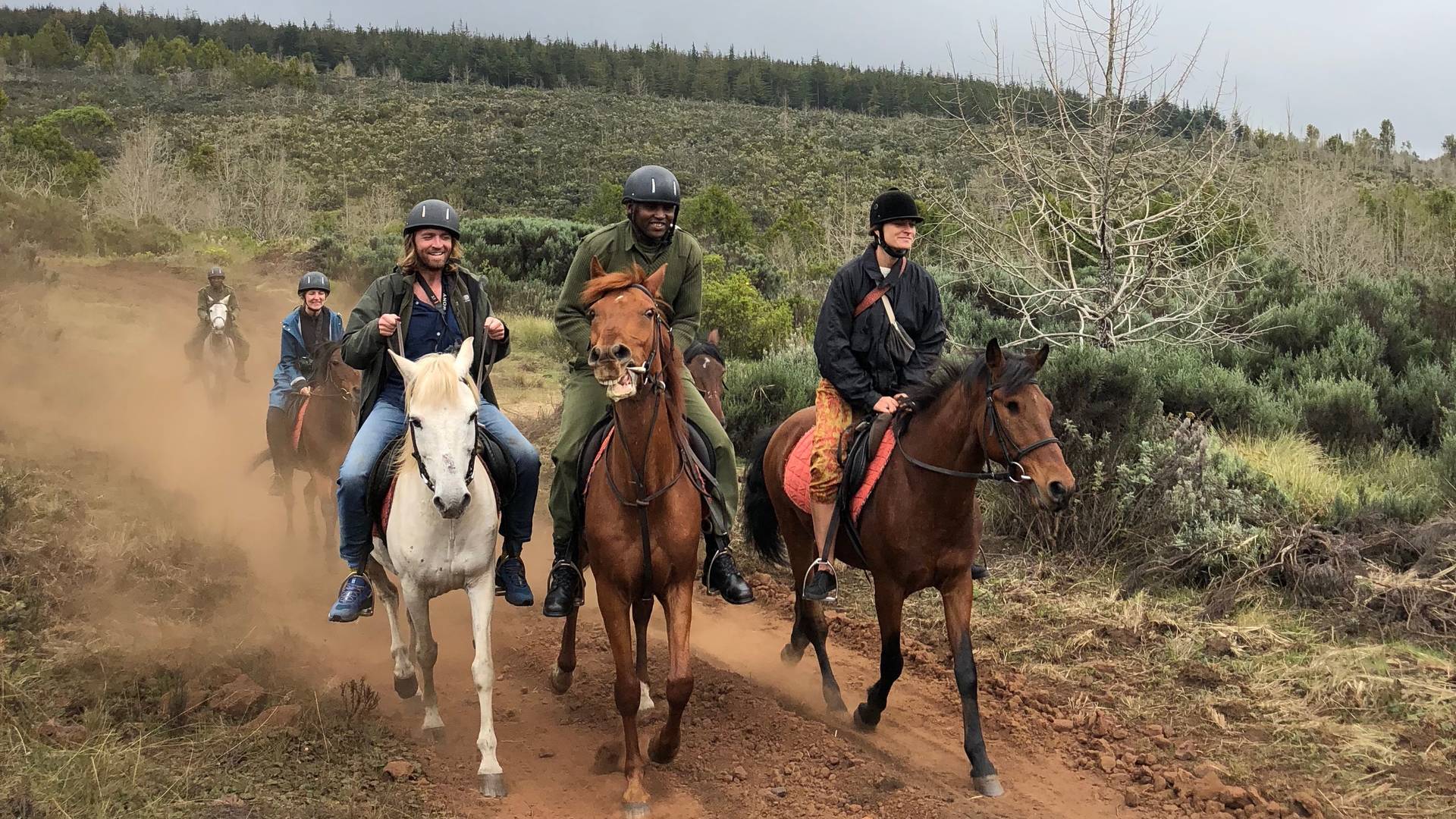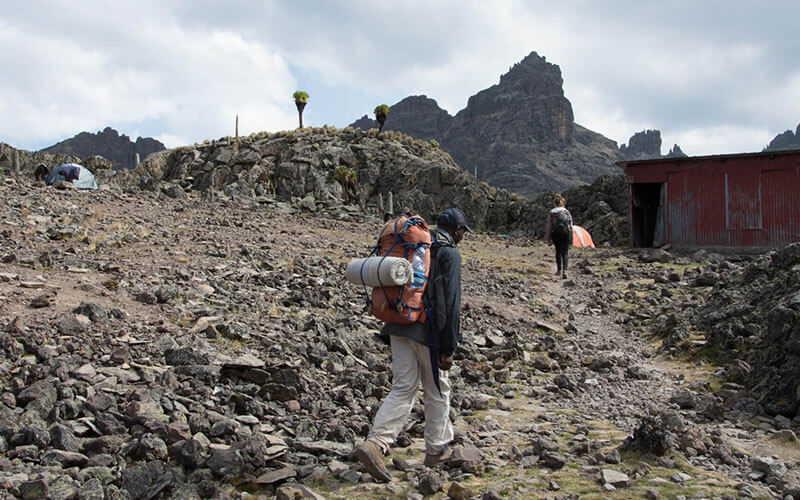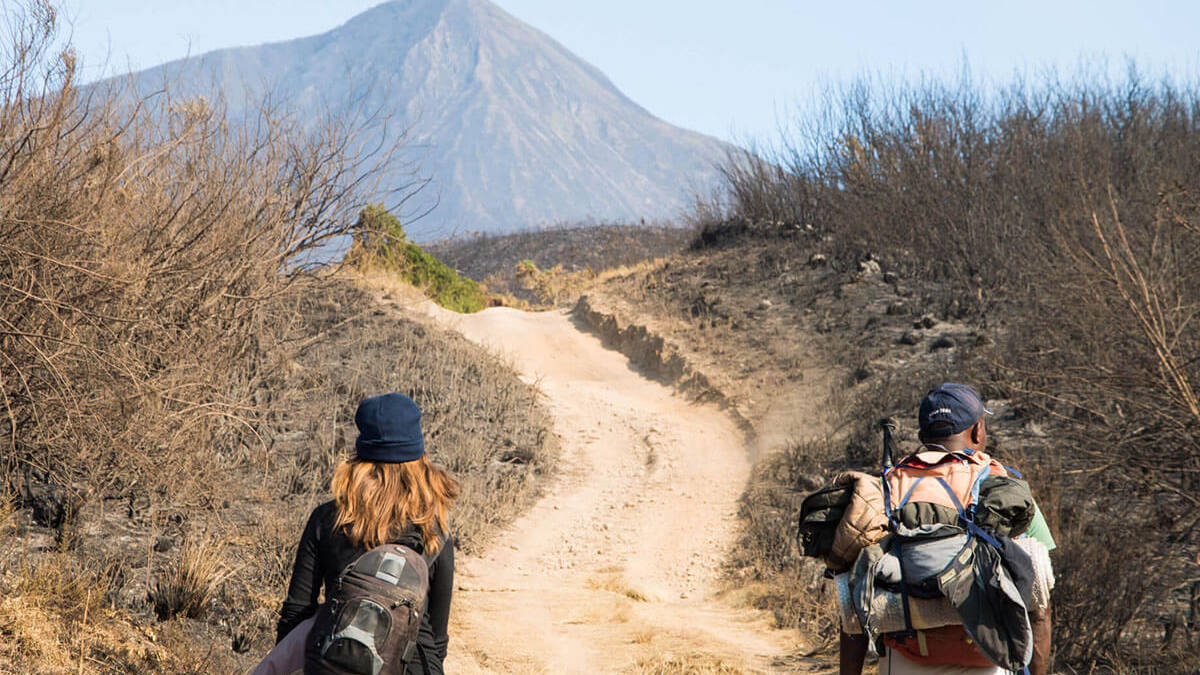Mount Kenya at higher level
Mount Kenya: after Kilimanjaro, the second highest mountain in Africa! Whether you’re a climber at heart, hauling yourself to the top, or prefer to wander pole pole around the base of the mountain: Mount Kenya offers the most beautiful and diverse landscapes, and you’ll be almost overrun by wildlife. The highest peaks are Batian (5199m), Nelion (5188m), and Point Lenana (4985m), with Batian and Nelion only accessible to highly experienced climbers. Point Lenana is the summit reached by most climbers. It’s a three to five-day climb through forests, golden grasslands, into an increasingly Bob Ross-like environment. As you ascend, the rocks become higher, and the vegetation becomes scarcer. There are several glaciers on the mountain, with Lewis Glacier being the largest and most famous. This glacier is clearly visible from Point Lenana.
At the foot of Mount Kenya...
At lower levels around Mount Kenya, there is also more than enough to do! Besides hiking, jeep safaris or boat safaris, you can also explore the area on horseback here! The Ragati River is one of the best spots in Kenya for fishing. The ideal habitat for rainbow trout! From this area, you can continue towards the North where there are several National Parks, rich in wildlife. Safari Njema!
Africa Inside Out: Fairytale Mount Kenya
For the Africa Inside Out project, we travelled to northern Kenya to see the different types of conservancies and develop new sustainable experiences. This included Mount Kenya: the third-highest mountain in all of Africa and an absolute must-see when in Kenya. From mysterious forests to fertile moorlands, bamboo zones and all kinds of wildlife. We went on horse patrol here, searching for poachers!
Mount Kenya fun facts
Mount Kenya may not be the roof of Africa, but it is definitely the roof of Kenya. At 5199 metres high, it is the second highest mountain (stratovolcano) in Africa after Kilimanjaro. Its highest peaks are Batian (5199m), Nelion (5188m) and Point Lenana (4985m), of which Batian and Nelion can only be reached by very experienced mountaineers. Point Lenana is the ‘summit’ reached by most hikers.
There are several glaciers on Mt Kenya, which are unfortunately slowly disappearing due to global warming. Lewis Glacier is the largest and best known and is clearly visible from Point Lenana. The temperature and weather on Mt Kenya varies enormously depending on the altitude and time of day. At the foot of the mountain at about 3,000 metres, the temperature fluctuates between 10 degrees at night and 20 degrees during the day; at the summit, it is drastically colder between -10 and +8 degrees Celsius! The days generally start bright and sunny, then later in the day clouds form and there is a greater chance of precipitation. Mt Kenya has two wet seasons (March to June and October to December) during which most precipitation (as snow) falls. Therefore, the best months for hiking are the dry seasons (i.e. the remaining months).
Whereas Mt Kilimanjaro really does recommend a minimum of 5 days of hiking, you can actually conquer Mt Kenya in just 4 days. So that gives you much more time to take on other cool adventures in Kenya. In addition, Mt. Kenya is considerably cheaper… where for Mt. Kilimanjaro you easily spend around $1,500 to $2,000, Mt. Kenya averages around $500 to $700 for 4 days. And that makes us thrifty Dutchies extra happy. Win-win situation, it seems to me!
Mt. Kenya Travel Story
It is a warm, sunny day when we (my friend Steven and I) are in the car in Nairobi on our way to the mountain village of Chogoria. We were picked up early by our guide Kenneth, who goes through our luggage before departure. Good shoes, check. Plenty of water bottles, check. Warm jacket, gloves and hat, check. The oh-so-loved espresso coffee pot (can’t live without it)… “No, sorry, too heavy”. In a good three hours we drove to our destination at the foot of Mt Kenya, where we were treated to a delicious and hearty Kenyan lunch.
After Kenneth fetched extra water and food in the meantime, we met our cook who continued driving with us. It’s another hour or so of driving on a dusty, dirt road, right through the dense forests at the foot of the mountain. On the way, we pick up our porters; two sociable and good-humoured men. Arriving at the gate, warnings of the fierce forest fires raging through the area at the time quickly become clear.
Large plumes of grey smoke trailed over the mountains as if they were low-hanging clouds. After a brief consultation with the rangers, it was decided for us that it is not safe to leave and camp on the mountain today. Tomorrow we may leave. Tonight we sleep in a fine banda, where there is delicious cooking for us and we drink tea by the fireplace before crawling under the covers early.
The next morning we got up early. After a hearty breakfast, we set off. We hiked 14 kilometres through extraordinary landscapes. From yellow grasslands to blackened fields… slowly uphill until we arrived in a kind of out-of-earth environment. The landscape gets more and more dramatic, the rocks higher and higher and the vegetation less and less.
As we plod up, our porters (with our luggage and tents and cooking gear on their backs) sprint past us. Arriving at Mintos Tarn (4300m), they pitch the tent, make tea and we get another load of snacks and food.
This surprisingly, after the long hike and climb, does not really go down the throat. An obvious consequence of altitude sickness. Although we feel fine (apart from a slight headache), it is cold and everything seems to take a lot of energy. After an early dinner, we crawl into the tent and then it starts to get really cold. Sleeping with all clothes and hiking gear on is the best solution….
Around 02:30 the alarm clock rings again. Hat on, lights on our heads, thermal underwear on, shirts, fleece jumpers, thick jacket… by now it’s -5 outside. Everything is freezing cold and our water bottles are frozen, but we set off in good spirits. The first two hours up are tough, but go fine. And then suddenly comes the inevitable feeling; why am I doing this? Every step gets heavier and there seems to be no end in sight. The cold is coming in really hard now and you feel like you are shuffling up just centimetres per step. Around 6 o’clock, we suddenly see other climbers appear out of the darkness: small headlamps appear from different directions. Everyone is continuing towards the summit!
Fellow climbers encourage each other and help each other up. I see a little flag (the summit??) but still really think it’s a joke, and that altitude sickness has officially driven me crazy. The last stretch is steep and incredibly tough. But then suddenly we are there. The sun is rising, in this unforgettable place.
We both have to cry. From exhaustion; from emotion. Totally broken, heartbroken, yet also grateful that we get to experience this special moment. We take a photo with the famous sign; 4,985-metre Lenana Summit: a once in a lifetime experience! As we stare silently at the rising sun over the horizon, we are helped out of our dream by Kenneth, our guide. It’s time to descend again.
It is quite a tough trek back to Mintos. The loose gravel on the steep slope (read: weak legs) make it hard to keep grip. So we skid from rock to rock until the landscape finally flattens out again.
At Mintos, we are congratulated by the team and treated to a delicious well-deserved breakfast. But we don’t have much time to relax. At 11 o’clock sharp, we are back in our shoes with ‘fresh’ courage to walk the last stretch back to the bandas at the gate. I won’t lie: it was tough. Really tough. But the welcome we got there from the team and a few fellow hikers made the fatigue disappear like clouds before the sun.







